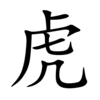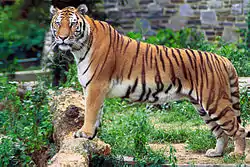虎
| ||||||||
| ||||||||
Translingual
| Stroke order | |||
|---|---|---|---|
| Stroke order | |||
|---|---|---|---|
 | |||
Han character
虎 (Kangxi radical 141, 虍+2, 8 strokes, cangjie input 卜心竹弓 (YPHN) or 卜心竹山 (YPHU), four-corner 21217, composition ⿸虍儿(JKT) or ⿸虍几(GV))
References
- KangXi: page 1073, character 3
- Dai Kanwa Jiten: character 32675
- Dae Jaweon: page 1539, character 23
- Hanyu Da Zidian (first edition): volume 4, page 2819, character 2
- Unihan data for U+864E
Chinese
Glyph origin
| Historical forms of the character 虎 | ||||||
|---|---|---|---|---|---|---|
| Shang | Western Zhou | Spring and Autumn | Warring States | Shuowen Jiezi (compiled in Han) | ||
| Oracle bone script | Bronze inscriptions | Bronze inscriptions | Chu slip and silk script | Qin slip script | Ancient script | Small seal script |
 |
 |
 |
 |
 |
 |
 |
| Old Chinese | |
|---|---|
| 唬 | *qʰraːs, *kʷraːɡ |
| 戲 | *qʰral, *qʰrals, *qʰaː |
| 巇 | *qʰra |
| 隵 | *qʰra |
| 嚱 | *qʰras |
| 盧 | *b·raː |
| 鑪 | *raː |
| 壚 | *raː |
| 籚 | *raː |
| 蘆 | *raː, *ra |
| 顱 | *b·raː |
| 髗 | *b·raː |
| 鱸 | *raː |
| 攎 | *raː |
| 櫨 | *raː |
| 轤 | *raː |
| 黸 | *raː |
| 獹 | *raː |
| 鸕 | *raː |
| 艫 | *raː |
| 纑 | *raː |
| 瀘 | *raː |
| 瓐 | *raː |
| 爐 | *raː |
| 嚧 | *raː |
| 矑 | *b·raː |
| 罏 | *raː |
| 蠦 | *raː |
| 虜 | *raːʔ |
| 擄 | *raːʔ |
| 艣 | *raːʔ |
| 鐪 | *raːʔ |
| 虖 | *qʰaː, *qʰʷa, *qʰaː, *qʰʷa |
| 虍 | *qʰaː |
| 雐 | *qʰʷlaː |
| 虎 | *qʰlaːʔ |
| 琥 | *qʰlaːʔ |
| 萀 | *qʰlaːʔ |
| 臚 | *b·ra |
| 廬 | *ra |
| 驢 | *b·ra |
| 藘 | *ra |
| 爈 | *ra, *ras |
| 櫖 | *ra, *ras |
| 儢 | *raʔ |
| 慮 | *ras |
| 勴 | *ras |
| 鑢 | *ras |
| 濾 | *ras |
| 攄 | *r̥ʰa |
| 處 | *kʰljaʔ, *kʰljas |
| 豦 | *kas, *ɡa |
| 據 | *kas |
| 鐻 | *kas, *ɡa, *ɡaʔ |
| 澽 | *kas, *ɡas |
| 虛 | *kʰa, *qʰa |
| 墟 | *kʰa |
| 懅 | *ɡa |
| 蘧 | *ɡa, *ɡʷa |
| 籧 | *ɡa |
| 醵 | *ɡa, *ɡas, *ɡaɡ |
| 璩 | *ɡa |
| 虡 | *ɡaʔ |
| 遽 | *ɡas |
| 勮 | *ɡas |
| 噓 | *qʰa, *qʰas |
| 驉 | *qʰa |
| 歔 | *qʰa |
| 魖 | *qʰa |
| 膚 | *pla |
| 虧 | *kʰʷral |
| 噱 | *ɡaɡ |
| 臄 | *ɡaɡ |
| 劇 | *ɡaɡ |
| 諕 | *qʰʷraːɡ |
Pictogram (象形) . 虍 represents the tiger's head. The torso has disappeared and the legs and the tail have transformed into 人 in the small seal script and later 儿 in the clerical script.
Etymology 1
| trad. | 虎 | |
|---|---|---|
| simp. # | 虎 | |
| alternative forms | ||

From Proto-Sino-Tibetan *k-la (“tiger”), from Proto-Mon-Khmer *klaʔ (“tiger”). Cognate with 菟 (OC *daː) in 於菟 (OC *qa daː, “tiger”). Compare Vietnamese khái ("tiger").
Pronunciation
Definitions
虎
- tiger
- 老虎 ― lǎohǔ ― tiger
- (figurative) brave; fierce
- a surname
- (Northeastern Mandarin, derogatory) overbold; stupid
Synonyms
Compounds
|
|
|
Pronunciation
Pronunciation
References
- “Entry #4498”, in 臺灣閩南語常用詞辭典 [Dictionary of Frequently-Used Taiwan Minnan] (in Chinese and Min Nan), Ministry of Education, R.O.C., 2011.
Japanese
Etymology
| Kanji in this term |
|---|
| 虎 |
| とら Grade: S |
| kun’yomi |
From Old Japanese to1ra.[1][2]
Pellard (2013:92) includes to1ra among words with o1 excepted from the /-o-/ to /-u-/ vowel-raising rule and not originating from earlier diphthongs. According to Vovin (2021:111), West Old Japanese *to1ra, instead of expected *tura, is "anomalous" and possibly "a case of a sporadic analogical development".[3]
Vovin (2013) asserts this word is same as a Silla place name 刀良 (/*tora/).[4]
Usage notes
As with many terms that name organisms, this term is often spelled in katakana, especially in biological contexts (where katakana is customary), as トラ.
Derived terms
- 牡虎 (osutora): a male tiger
- 雌虎 (mesutora): a female tiger
- 虎燕拳 (koenken)
- 虎穴 (koketsu)
- 虎口 (kokō)
- 虎視眈々 (koshitantan)
- 虎狼 (korō)
- 虎魚 (okoze)
- 虎巻 (torakan)
- 虎刈り (toragari)
- 虎狩り (toragari)
- 虎猫 (toraneko)
- 虎髭 (torahige)
- 虎鬚 (torahige)
- 虎斑 (torafu)
- 虎河豚 (torafugu)
- 大虎 (ōdora)
- 小虎 (kodora)
- 暴虎馮河 (bōkohyōga)
- 猛虎 (mōko)
- 虎落 (mogari)
- 虎落笛 (mogaribue)
- 竜虎 (ryūko), 竜虎 (ryōko)
- 竜攘虎搏 (ryūjōkohaku)
- 両虎 (ryōko)
- 虎に成る (tora ni naru)
- 寅 (tora)
References
- National Institute for Japanese Language and Linguistics (2020), “Old Japanese twora”, in Oxford-NINJAL Corpus of Old Japanese
- Thomas Pellard. Ryukyuan perspectives on the proto-Japonic vowel system. Frellesvig, Bjarke; Sells, Peter. Japanese/Korean Linguistics 20, CSLI Publications, pp.81–96, 2013, 9781575866383. ffhal01289288
- Vovin, Alexander (2021), “Names of Large Exotic Animals and the Urheimat of Japonic”, in International Journal of Eurasian Linguistics, issue 3, pages 105-120
- Vovin, Alexander (2013), “From Koguryo to T'amna”, in Korean Linguistics (PDF), volume 15, issue 2, John Benjamins Publishing Company, , pages 222-240
- 1998, NHK日本語発音アクセント辞典 (NHK Japanese Pronunciation Accent Dictionary) (in Japanese), Tōkyō: NHK, →ISBN
- 2006, 大辞林 (Daijirin), Third Edition (in Japanese), Tōkyō: Sanseidō, →ISBN
Korean
Etymology
From Middle Chinese 虎 (MC huoX). Recorded as Middle Korean 호〯 (hwǒ) (Yale: hwo) in Hunmong Jahoe (訓蒙字會 / 훈몽자회), 1527.
Compounds
Okinawan
Pronunciation
- IPA(key): [tuɾa]
References
- “とぅら【虎】” in JLect - Japonic Languages and Dialects Database Dictionary, 2019.